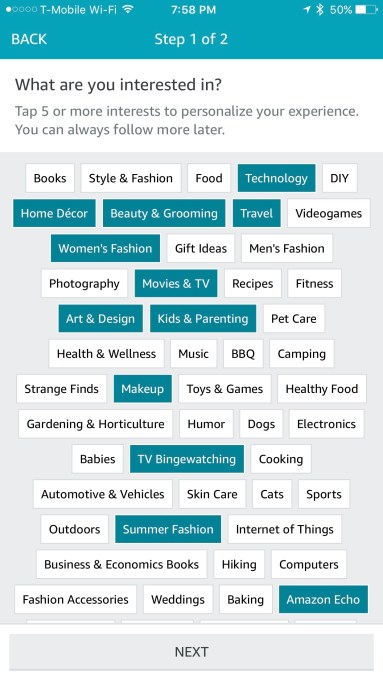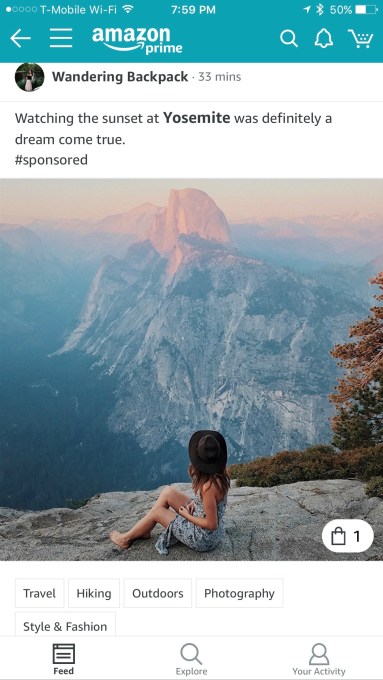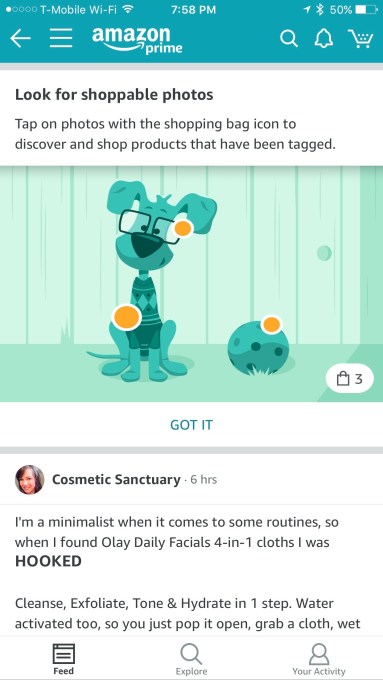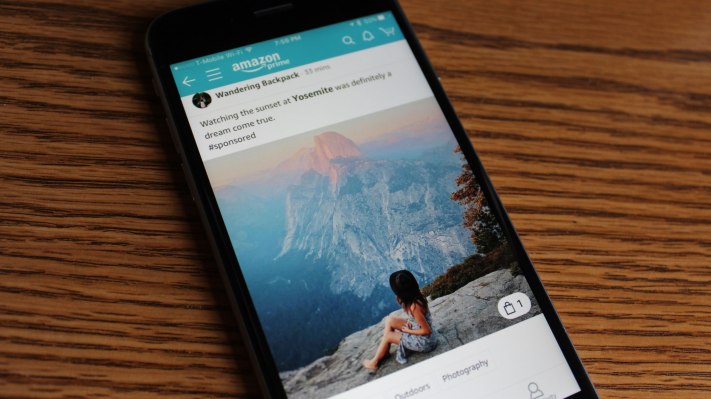Amazon today is launching Amazon Spark, a new feature aimed at improving product discovery, which is seemingly inspired by Instagram and its use of shoppable photos. Similarly, Amazon Spark users are encouraged to post stories, ideas and images of products they love, which others can react to with comments and “smiles” – Amazon’s own version of the Like or Favorite button.
The retailer has been quietly testing Amazon Spark in beta for a few months before today’s launch to consumers in the U.S. The goal with the new program is to shift some of the social activity around products taking place off-site back to Amazon, where product inspiration can translate directly into purchases with a click of a button.
In this way, Amazon Spark could be seen as something of a Pinterest competitor, as well, but the actual format for the service is a feed-style interface – which is why the comparison with Instagram seems more apt.
To get started with Amazon Spark, you have to use the Amazon mobile app, as the feature is not designed for desktop use at this time.

When you first join Spark – it’s available through the “Programs & Features” menu option in the app’s navigation – you’re asked to select at least five interests you want to follow. Using this information, Amazon Spark will create a customized feed of products, imagery and ideas that will relate to the sort of things you like to shop for, or learn more about.
You can select more than five interests, but you can’t proceed until you’ve chosen a minimum of five categories.
[gallery ids="1515883,1515888,1515880,1515889,1515884,1515881"]
These interests vary, and generally tend to match up with Amazon’s own popular merchandise categories, like “Books,” “Style & Fashion,” “Technology,” “Home Décor,” “Music,” “Fitness,” “Toys & Games,” and many more. But there are also a number of niche categories like “TV Bingewatching,” “Cats,” “Internet of Things,” “BBQ” and others that are much more specific and narrowly focused.
Once you’ve completed the setup – which also includes entering your name and optionally enabling notifications for updates to your Spark posts and responses to comments – you’ll then be presented with an image-heavy feed of product ideas and other stories. In some cases, these posts will read more like a product review – someone detailing their personal experience with an item, for example.

Other times, you might just see a beautiful photo, where the product being sold is less obvious – similar to the sort of fashion inspiration photos you’d come across on Instagram.
When a photo contains a product Amazon sells, there will be a shopping bag icon in the bottom right corner with a number that indicates how many items from the photo can be shopped on Amazon’s site.
For example, in the below photo of a woman watching the sunset at Yosemite, a click on the shopping bag icon will take you to the product detail page for the hat she’s wearing.

In addition to lifestyle imagery, Spark posts can also contain product photos, text, links or polls.
The ability to shop the photos on Amazon’s site is a much more seamless experience than on Instagram, where often the fashion labels’ Instagram handles are tagged in the photos, but you’re not provided with a way to go directly to product pages themselves for the numerous pieces of clothing and accessories tagged.
Or, if you manage to hunt the product in question down, you sometimes find it’s no longer sold or out of stock. That shouldn’t happen on Amazon Spark, thanks to the way the product images are connected with Amazon inventory.
To some extent, the retailer sees Amazon Spark as a new frontier for product reviews. With Spark, Amazon is moving away from rewarding “Top Reviewers” who write up their thoughts and rate items, and is rather embracing a new system that rewards those who are “Enthusiasts” instead.
Enthusiasts will also receive a badge, which appears when they post to Spark or write product reviews.

Anyone can become an Enthusiast by contributing to Spark, but there’s a catch – to post, you have to be an Amazon Prime member. Non-Prime members can browse Spark’s feed, but can’t post or comment.
Encouraging product discovery is a newer focus for Amazon, which has also been steadily upgrading its curated shop of product ideas, “Interesting Finds,” with personalized suggestions based on users’ activity and shopping patterns, through a feature called “My Mix.” It also quietly began testing its own invite-only influencer program, which allows consumers to connect with Amazon products via influencer posts across social media.
Amazon Spark isn’t directly connected with either of those earlier programs, but it does have a similar goal of helping people more serendipitously discover new things they might like to buy.
It also lays the groundwork for a social network that lives right on Amazon, as customers’ user profiles – which have been around for years, but aren’t really well known – now become a much more prominent part of the Amazon experience.
In the future, one could imagine that users will also be able to generate some sort of income via their Spark postings. Making money from product suggestions posted to Spark is not an aspect to this program Amazon is prepared to discuss today. But an influencer-courting service like this will eventually need to nail down a monetization angle if it truly wants to challenge Instagram – a place where the most-followed users can make five or six figures for their posted photos and campaigns.
In the near-term, however, Amazon will focus on helping seed Spark with more content. On July 30, it will begin to allow users to share their previously written product reviews from their profile to Spark, for example.
Amazon Spark is available today in the U.S., only in the Amazon iPhone application.
